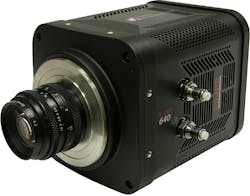The PIoNIR:640 scientific-grade camera utilizes a 640 × 512 pixel indium gallium arsenide (InGaAs) focal-plane array with thermoelectric cooling down to -90°C. It is specifically designed for use in low-light NIR or SWIR imaging and spectroscopy applications that require high sensitivity from 0.9 to 1.7 μm. Applications range from nanotube fluorescence imaging to photovoltaic (PV) inspection.
Princeton Instruments
Trenton, NJ
www.princetoninstruments.com
More Products
-----
PRESS RELEASE
FOR IMMEDIATE RELEASE
Deep-Cooled, 640 x 512 InGaAs Camera Engineered for Advanced Low-Light NIR/SWIR Applications in Life and Physical Sciences
Trenton, New Jersey, December 19, 2011 — Princeton Instruments is pleased to introduce the PIoNIR:640, the world’s first scientific-grade camera to utilize a deep-cooled InGaAs (indium gallium arsenide) focal plane array. The PIoNIR™ is specifically designed for use in challenging low-light near infrared (NIR) or shortwave infrared (SWIR) imaging and spectroscopy applications that require high sensitivity from 0.9 µm to 1.7 µm. PIoNIR applications range from cutting-edge nanotube fluorescence imaging to photovoltaic (PV) inspection.
“The PIoNIR:640 is a very unique NIR/SWIR camera in today’s market. It combines the advantages of the latest-generation 640 x 512 InGaAs array [peak quantum efficiency: >80%] with thermoelectric cooling [down to -90°C] and low-noise readout electronics to deliver the highest possible sensitivity in this important wavelength range,” notes Ravi Guntupalli, product manager for Princeton Instruments’ Imaging Group. “The PIoNIR sets a new performance benchmark, enabling novel research and industrial applications in diverse life and physical science areas such as semiconductor failure inspection, singlet oxygen imaging, PL [photoluminescence] imaging of PV materials, NIR fluorescence and absorbance, and deep tissue imaging.”
Previous-generation InGaAs cameras required liquid nitrogen to achieve deep cooling but thanks to state-of-the-art vacuum technology developed at Princeton Instruments the new PIoNIR:640 reaches temperatures as low as -90°C using convenient, maintenance-free thermoelectric cooling. As a result, unwanted thermal noise is minimized to achieve the best possible signal-to-noise ratio. The camera offers either built-in air or liquid cooling, or a combination of the two, for use in thermal- and vibration-sensitive environments.
The PIoNIR:640 also features a Gigabit Ethernet (GigE) data interface for remote operation from up to 50 meters away and delivers a maximum frame rate of 110 frames per second at full resolution.
The new camera is available with the latest Princeton Instruments LightField™ data acquisition software, which affords complete control over all PIoNIR:640 hardware features via an exceptionally intuitive user interface. LightField provides automatic defect correction, exposure control up to minutes, and a host of innovative functions for easy capture and export of imaging and spectral data. The PIoNIR:640 can be integrated into OEM systems using the PICAM™ SDK, a free software development kit from Princeton Instruments.
About Princeton Instruments
Princeton Instruments designs and manufactures high-performance CCD, ICCD, EMCCD, and InGaAs cameras; spectrographs; and optics-based solutions for the scientific research, industrial imaging, and OEM communities. We take pride in partnering with our customers to solve their most challenging problems in unique, innovative ways. For more information on Princeton Instruments products, please visit www.princetoninstruments.com.
-----
Follow us on Twitter
Subscribe now to Laser Focus World magazine; it's free!
Sponsored Recommendations
Sponsored Recommendations
Request a free Micro 3D Printed sample part
April 11, 2024
How to Tune Servo Systems: The Basics
April 10, 2024
Voice your opinion!
Voice your opinion!
